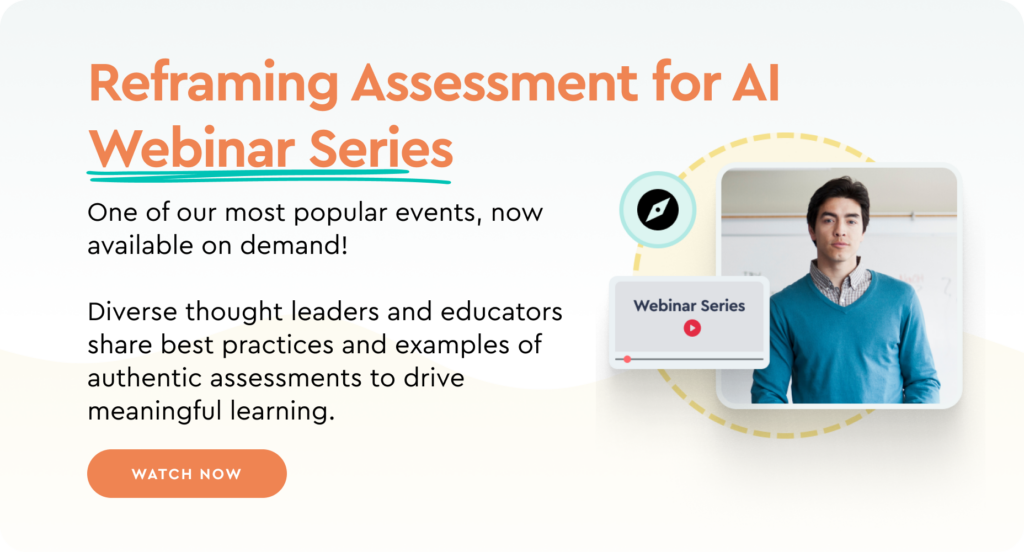The integration of Artificial Intelligence into various industries has been nothing short of revolutionary. In higher education, AI has disrupted campuses, leaving every stakeholder — from students to professors to chief academic officers — trying to understand its capabilities and implications as rapidly as it seems to be transforming.
As AI tools continue infiltrating academia, it’s essential for higher ed faculty to understand both the promises and disruptions it brings to the learning environment. This blog will explore both the advantages and shortcomings so faculty can find ways to leverage these tools and areas to navigate this new landscape and continue focusing on what’s most essential … helping students learn, grow and be prepared for work.
Let’s start with the advantages of AI.
Saves Time by Automating Tasks
AI tools can save faculty countless hours grading tests and other assignments. AI can also quickly generate new content like quizzes and tests, saving instructors time from doing these tasks. Using prompts with tools like ChatGPT, instructors can easily create a syllabus, or generate a list of recommended course-related readings. Time saved on these tasks can be used for more impactful activities like curriculum planning and providing meaningful feedback to students.

Enhances Student Support
Unlike students, most instructors like to shut off their devices and get some sleep. Students, on the other hand, are studying at all hours of the day and night, and AI tools are accessible around the clock, so they can use these tools as a study tool that never goes to sleep. Not only does this benefit students, but the instant and round-the-clock accessibility frees up time for faculty and staff.
Provides Personalized Learning
The capabilities of some AI tools include consuming and analyzing large volumes of data about a student’s learning, and provide instructors with valuable insights, making very specific recommendations for instructional approaches and materials that resonate with that particular student and address their individual needs. For students who may be struggling in some areas, AI-driven tutoring tools can monitor progress, detect weaknesses and offer guidance and resources to support a student’s learning and engagement.
Now on to the shortcomings …

Makes Cheating More Prevalent
The truth is, if a student wants to cheat, they will find a way. The widespread accessibility and integration of AI tools has made it even easier for students to rely on technology to do their work. This isn’t always a bad thing. The reality is that most students will need to use AI at some point in their careers, so learning how to use these tools can certainly benefit students. But it shouldn’t be the only way students learn.
Apply the calculator model to your curriculum, allowing AI for certain assignments but not all, and assume that students will use these tools. This approach promotes diversifying opportunities for learning and assessing, promoting more experiences that allow students to practice and develop skills they’ll need beyond the classroom, and provide evidence of learning.

Limits Creativity
If students are given a creative assignment like writing an essay or creating a marketing plan and they ask ChatGPT to complete the assignment, they aren’t thinking or exercising creative thought. Done repeatedly, over reliance on these AI tools stunts learning and growth and prevents students from developing skills like critical thinking and problem solving that they will need in work and life.
Removes the Human Element
AI tools aren’t capable of providing the supportive, empathetic, and motivating learning approach that instructors do. For students, ChatGPT and other generative AI tools may be able to provide research for a thesis, but they aren’t a replacement for the skill development and practice that students gain by presenting their thesis. These are the skills and competencies that recruiters look for, and three out of four employers say they have trouble finding grads that have these soft skills. If we limit work-relevant learning in favor of machine-generated learning, we’ll set future hires back even further.
The bottom line is based on what we currently know (which may change tomorrow), it’s important to strike a balance on AI integration in education, and use these tools as a complementary learning tool. Instead of continuing to see this technology as a threat, it’s time to embrace its benefits while rethinking traditional methods of teaching and assessing
Authentic assessments are a way to ensure that students are mastering the skills that they’ll need to succeed in their careers.











